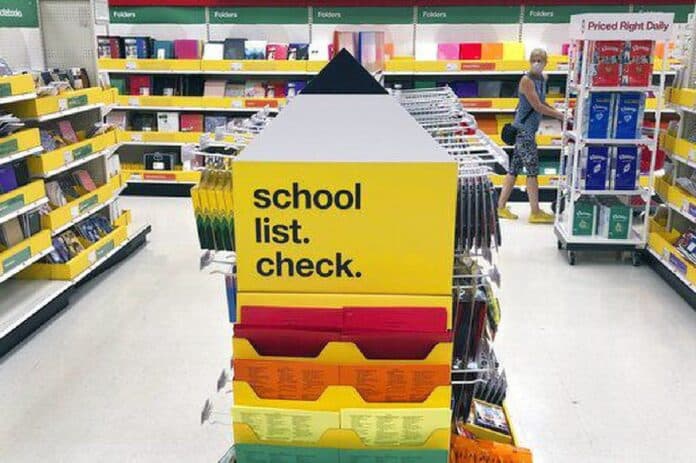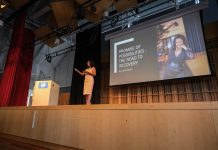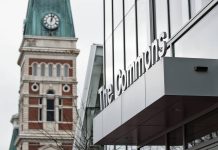
As school administrators across the state weigh how to balance risks and benefits of reopening schools, health officials are worried the number of coronavirus infections and hospitalizations could increase when hundreds of thousands of students in Indiana return to in-person instruction.
Bartholomew Consolidated School Corp. school board members will consider tonight whether to approve BCSC’s plan to reopen schools for in-person instruction on Aug. 6. Flat Rock-Hawcreek School Corp., which plans to restart school on Aug. 4, released a new draft of reopening guidelines late last week. Both school corporations are offering the option of remote learning to parents who may not want to send their children to school in two weeks.
The decisions on reopening schools will come as state officials continue to pause fully reopening the state after the number of COVID-19 hospitalizations and the percentage of tests coming back positive for the virus have increased in recent weeks.
So far, hospitalizations have remained relatively stable in Bartholomew County. On Thursday, there were two people hospitalized with COVID-19 at Columbus Regional Hospital, with test results still pending for three additional patients, CRH officials said. A total of 45 Bartholomew County residents had died from the virus as of Friday.
[sc:text-divider text-divider-title=”Story continues below gallery” ]
“I think we definitely will see an increase in the number of cases (in Indiana). I don’t think there’s any question on that because it will spread through the kids to some extent and their parents will likely get it,” said Dr. Raymond Kiser, medical director of hospital care physicians at Columbus Regional Health. “And even though the kid may be asymptomatic, their parents may not. I suspect their parents are probably still going to do OK and we’ll probably see a little bit of an uptick in hospitalizations from that.”
Kiser said what is really concerning is what happens to the grandparents of those families, and to older teachers in the classroom.
“What I really worry about is what happens to their grandparents and then, honestly, what happens to our teachers because … we don’t have a particularly young set of teachers. Some of our teachers are in that older population and so I guess I would not be entirely surprised if we did see a couple weeks after going back to school this increased hospitalization, increased (emergency department) visits, and increased rate — probably not in the young population, but probably as they transmit it on to their grandparents or some of the older generation.”
Kiser, a hospitalist, has been one of many doctors on the front lines of the pandemic in Bartholomew County, helping direct care for COVID-19 patients at Columbus Regional Hospital.
In the middle
Educators across the country are being pushed in the middle of an increasingly politicized debate on how best to reopen schools this fall, a daunting challenge as infections spike in the U.S., according to reporting by The Associated Press.
President Donald Trump has ramped up pressure to get public schools back in business, threatening to withhold federal funding from those that don’t resume in-person classes. Without evidence, he’s accused Democrats of wanting schools closed because of politics, not health.
In the medical community, however, there is no debate — doctors are saying masks are an effective way of preventing the spread of COVID-19 and could help avoid tens of thousands of preventable deaths across the country.
The latest projection from the University of Washington in Seattle’s Institute of Health Metrics and Evaluation estimates that 33,000 deaths could be prevented across the U.S. — including a few hundred in Indiana — by Oct. 1 if 95% of people wore masks in public.
“There is no doubt that even as states open up, the United States is still grappling with a large epidemic on a course to increase beginning in late August and intensifying in September,” said IHME Director Dr. Christopher Murray in a statement on the organization’s website. “People need to know that wearing masks can reduce transmission of the virus by as much as 50%, and those who refuse are putting their lives, their families, their friends and their communities at risk.”
Additionally, numerous studies have shown that masks can help reduce the spread of the virus, including a study published June 11 in the Proceedings of the National Association of Science in which researchers from Texas A&M University, the University of Texas at Austin, the California Institute of Technology and others concluded that wearing masks “significantly reduces the number of infections.”
“We conclude that wearing of face masks in public corresponds to the most effective means to prevent interhuman transmission, and this inexpensive practice, in conjunction with simultaneous social distancing, quarantine and contact tracing, represents the most likely fighting opportunity to stop the COVID-19 pandemic,” according to the study authors.
Local doctors and officials are agreeing that wearing masks can help reduce the chances of spreading the virus and have urged local residents to wear masks while in public or without opportunities to socially distance.
Some parents are calling on students and school staff to be required to wear masks while inside school buildings this fall.
Letter from pediatricians
On July 8, 12 pediatricians in Bartholomew County sent a joint letter to BCSC Superintendent Jim Roberts and the school board, voicing “strong support” for a mandatory rule that students and staff wear cloth face coverings while inside BCSC buildings this fall, according to a copy of the letter.
Columbus Mayor Jim Lienhoop has said in a previous interview that one of the keys to the community’s response to the pandemic so far was BCSC’s decision to pivot to eLearning after spring break as coronavirus infections and hospitalizations were dramatically increasing across much of Indiana and the U.S.
BCSC officials said in a statement that the “expectation” will be for its students and staff to wear face coverings and will require them to be worn when physical distancing is not possible, including while students are in hallways, awaiting entrance screenings, participating in group activities and taking the bus.
“While there is much we do not know about the coronavirus, we do know that wearing cloth face coverings or masks dramatically decreases the transmission of the virus from one person to another in indoor spaces,” the pediatrician joint letter to BCSC states. “This is particularly important because a large number of people who are infected with the virus can be asymptomatic. This means they do not have symptoms of being ill and do not have fever, but they can still transmit the virus to others.”
Additionally, the pediatricians said they “believe that the best place for most children to learn is in school” but only “when their health and safety are protected,” the letter states.
Many parents, educators and doctors agree that the social, educational and emotional costs to children of a long shutdown may outweigh the risk of the virus itself, even if they don’t agree on how to reopen safely, according to wire reports.
The American Academy of Pediatrics has issued guidelines supporting in-person school to avoid social isolation and depression in students. But it said science, not politics, must guide decisions where COVID-19 is spreading.
Kiser said reopening schools is a “tough decision” and sympathizes with the people tasked with making it.
“I appreciate the fact that (BCSC officials) are really saying we want everyone to wear a mask when you can’t social distance,” Kiser said. “…Whether or not it’s the right move for us as a county, as a state, etc., I don’t know and I don’t know that anybody does. It’s just hard when you’re weighing potentially exposing people and the potential risk of death against social and economic and educational benefits and I don’t know that anybody has a scale that can do that correctly.”
[sc:pullout-title pullout-title=”For more information” ][sc:pullout-text-begin]
To learn more about proposed reopening plans for Bartholomew Consolidated School Corp. and options students and families have for instruction, visit bcscschools.org.
[sc:pullout-text-end]




